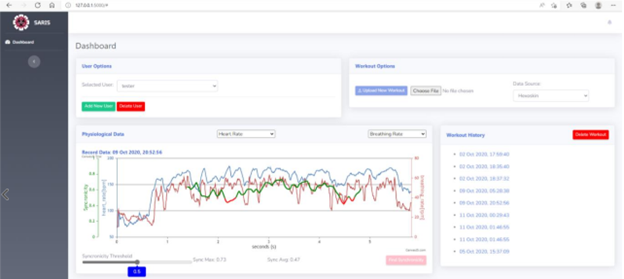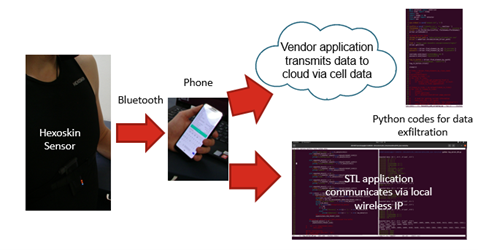
Performance Monitoring by Simultaneous Sensing of Internal Gas Exchange and Respiration Patterns—Pythia Phase III

Project #: 22-083 | Year 3 of 3
Erik Stassinos,a Paul Mendoza,a Scott Sonnonb
aSpecial Technologies Laboratory; bRemote Sensing Laboratory–San Diego
Executive Summary
This project evolution is exploring new methods in cardiorespiratory performance monitoring through a novel collection and observation tool kit. A multimodal approach to characterizing and predicting respiratory behavior using new analytics approaches will generate a tool set to consistently observe physiological response mechanisms and treatment solutions for stressors imposed on cardiorespiratory systems by physical fatigue or viral loading.
Description
The Pythia Site-Directed Research and Development (SDRD) project is creating real‐time monitoring of novel physiological parameters for the National Nuclear Security Administration and Strategic Partnership Projects (SPP) human performance. The same novel markers in dysfunctional breathing from fatigue are present in strained respiratory behavior of pre-symptomatic and post‐acute COVID‐19 “long haul” patients. It has also been found that cardio-respiratory linking is an observable trend in endurance athletes (Angelova et al. 2021). Phase II was able to extract laboratory data relating individualized breathing changes during fatigue events and highlight unique signals in Hexoskin respiratory sensor data indicative of changes in cardiorespiratory synchronicity (Lotrič and Stefanovska 2000), which will be discussed in depth later in this report and is represented by synchrogram Equation 1.
psi(tk) = 1/(2pi) * (Φr (tk)mod(2pi*m))(Eq. 1)
The synchrogram is constructed by plotting the corresponding normalized respiratory phase psi(tk) for every heartbeat within m respiratory cycles where tk is the time of the kth R peak and Φr is the corresponding respiratory phase.
Phase III made a strategic pivot from CapnoTrainer integration in Phase II, and focused on improving the utility and resolution of the collection tools with the Hexoskin kit. In the trade space between utility and interpretation of Hexoskin data for fatigue monitoring verses integrating a capnographic data stream, significant benefits presented themselves for a transition opportunity to Nevada National Security Site (NNSS) mission programs to focus on the Hexoskin for the final SDRD period. Capabilities in the tool kit were created for future data stream integration. The SDRD project team set down the path to optimize visualization tools and create an opportunity for near real time assessments without dependency on commercial-off-the-shelf (COTS) cloud platforms. This goal set was achieved successfully.


Conclusion
The Pythia Phase III SDRD achieved the ability to exfiltrate sensor data from commercial products in near real time capacity for analysis, provided an easily interpretable GUI indicating synchronicity, and created a basis for prediction tools. While creating the capacity to move COTS sensor data to analytics platforms without commercial cloud dependency, the SDRD collaborated with students at Brigham Young University (BYU) to generate a processing tool and GUI for automated trend analysis and visualization of the wearable sensor data. We expanded on the utility created by BYU to portray near real-time data indicative of observation during a stressor event, and apply machine learning tools to that data which will aid a user in taking a course of action to increase synchronicity and mitigate impact of stressors thus providing the basis for a portable assessment platform. The mathematical reduction of sensor data applied to the synchronicity value was investigated in depth to verify parameter correlation with temporal data products of the Hexoskin vest. While the first iteration of the machine learning capability only provides synchronicity prediction within a few sections from T(0) and the hardware is not in a polished form factor, the successful implementation of this kit function represents the first visual-interpretive system with sensor agnostic capability. This is a significant achievement in the field of respiratory science, and key step for SPP partners. Future opportunities to improve on the design will require more data to refine prediction tools, and improved form factor for the wearable device. This third year SDRD capability stands on its own as a demonstration tool that many NNSS customers need.
Mission Benefit
This project will position Mission Support and Test Services, LLC (MSTS) in the National Security Enterprise for advancing physical, cognitive, and socio-emotional performance (e.g. optimal performance in physical endurance, cognitive tests, and intelligence collection, which have each been characterized by synchronization in recent research) as well as in preclinical early detection of physiological decline (e.g. preventing contagious spread of COVID‐19 and early warning of “Havana” syndrome). The Pythia Phase III project has already received interest from critical United States government sponsors.
Publications, Technology Abstracts, Presentations/Posters
A patent pathway has been generated by work that the SDRD has undertaken. The SDRD has highlighted the understanding of current commercial sensor solutions, and their limitations in providing the necessary human performance assessment data and form factor to NNSS perspective partners. Provisional patent Nasal Appliance – MSTS.0070P is in final release phase.
Sonnon, S. B., E. Stassinos. 2022. Respiratory Sensor Patch. U.S. Provisional Patent 20220280113 A1, filed March 7, 2022, published September 8, 2022.
References
Angelova, M., P. M. Holloway, S. Shelyag, S. Rajasegarar, H. G. Laurie Rauch. 2021. “Effect of Stress on Cardiorespiratory Synchronization of Ironman Athletes.” Front Physiol. 12. https://doi.org/10.3389/fphys.2021.612245.
Lotrič, M. B., A. Stefanovska. 2000. “Synchronization and Modulation in the Human Cardiorespiratory System.” Physica A. 283: 451–461. https://doi.org/10.1016/S0378-4371(00)00204-1.
This work was done by Mission Support and Test Services, LLC, under Contract No. DE-NA0003624 with the U.S. Department of Energy. DOE/NV/03624–1657.
Return to Enabling Technologies for Autonomous Systems and Sensing
Go to SDRD Annual Report Index
Return to SDRD Homepage
